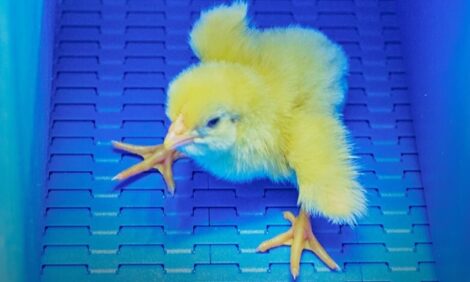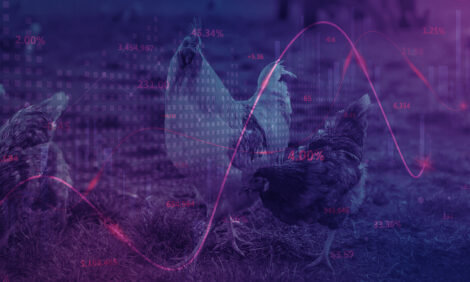



Weekly global protein digest: Egg prices scramble bakeries and restaurants
Livestock analyst Jim Wyckoff reports on global protein newsWeekly USDA US beef, pork export sales
Beef: Net sales of 24,900 MT for 2025 primarily for South Korea (3,900 MT, including decreases of 500 MT), Japan (3,300 MT, including decreases of 700 MT), China (2,500 MT, including decreases of 300 MT), the Dominican Republic (1,800 MT), and Ecuador (1,800 MT), were offset by reductions for the United Kingdom (100 MT). Exports of 19,800 MT were primarily to South Korea (5,700 MT), Japan (5,000 MT), China (3,700 MT), Mexico (1,500 MT), and Taiwan (1,400 MT).
Export Adjustments: Accumulated exports of beef were adjusted down 9,851 MT to the Dominican Republic (1,837 MT), Ecuador (1,765 MT), the Bahamas (1,442 MT), Guatemala (990 MT), Panama (417 MT), the Netherland Antilles (415 MT), Chile (395 MT), Qatar (393 MT), Mexico (347 MT), South Korea (269 MT), the United Arab Emirates (257 MT), Egypt (202 MT), Kuwait (197 MT), the U.S. Virgin Islands (167 MT), Bahrain (104 MT), Honduras (102 MT), Peru (98 MT), Jamaica (94 MT), the Turks and Caicos Islands (67 MT), Saudi Arabia (58 MT), El Salvador (50 MT), the Philippines (43 MT), Colombia (37 MT), Costa Rica (23 MT), Barbados (23 MT), Jordan (14 MT), Oman (12 MT), Lebanon (9 MT), Trinidad and Tobago (7 MT), Haiti (6 MT), Cayman Islands (5 MT), the Leeward Windward Islands (2 MT), Singapore (1 MT), Belize (1 MT), Guyana (1 MT), and Suriname (1 MT) for week ending January 23. These exports were reported in error.
Pork: Net sales of 50,700 MT for 2025 were primarily for Mexico (21,000 MT, including decreases of 600 MT), South Korea (7,200 MT, including decreases of 1,700 MT), Japan (6,500 MT, including decreases of 500 MT), the Bahamas (4,700 MT), and Colombia (3,600 MT, including decreases of 200 MT). Exports of 37,800 MT were primarily to Mexico (13,900 MT), Japan (5,500 MT), South Korea (4,000 MT), China (3,600 MT), and Canada (2,700 MT).
Export Adjustments: Accumulated exports of pork were adjusted down 6,487 MT to the Bahamas (4,690 MT), the Netherland Antilles (436 MT), the Dominican Republic (401 MT), Chile (289 MT), South Korea (236 MT), the U.S. Virgin Islands (118 MT), Haiti (92 MT), El Salvador (50 MT), Honduras (44 MT), Panama (37 MT), the Turks and Caicos Islands (29 MT), Guatemala (22 MT), Mexico (21 MT), Barbados (9 MT), Ecuador (8 MT), Nicaragua (3 MT), the United Arab Emirates (1 MT), and the Leeward Windward Islands (1 MT) for week ending January 23. These exports were reported in error.
Uncertainty surrounds the return of USDA’s July Cattle report
It remains unclear whether USDA’s National Agricultural Statistics Service (NASS) will reinstate the July Cattle Inventory report. In April 2024, NASS canceled the July Cattle report due to budget constraints, leaving the industry with only the January report for annual data. Industry groups, including the National Cattlemen's Beef Association, have urged NASS to reverse its decision. Bipartisan lawmakers have called on USDA to reinstate the report. NASS estimates it would take approximately $550,000 to fund the report.
Egg prices scramble bakeries and restaurants
Soaring egg prices — up more than 36% due to avian flu — are forcing bakeries and restaurants to rethink operations. Some have seen egg costs nearly double, making it harder to keep prices affordable. Nationwide, chains like Waffle House are adding surcharges to cope with the egg shortage. Waffle House is implementing a 50 cent surcharge for every egg in a customer’s order, according to Reuters. The Georgia-based company, which has about 2,100 locations nationwide, is believed to be the first major restaurant chain to add an egg surcharge. "Rather than increasing prices across the menu, this is a temporary targeted surcharge tied to the unprecedented rise in egg prices," the company said. "The continuing egg shortage caused by HPAI (Bird Flu) has caused a dramatic increase in egg prices," Waffle House said in a statement. "Consumers and restaurants are being forced to make difficult decisions." Other breakfast operators are similarly struggling to afford making omelets en masse, with some switching to liquid egg, which is cheaper.
Facts and figures. Roughly 104 million egg-laying birds have been put down over the past two years, with 29 million culled just since October. Over the past 30 days, USDA data shows 80 commercial flocks and 43 backyard flocks have been affected with a total of 22.75 million birds. Of that, Ohio has 39 commercial flocks with 8.79 million birds affected, Indiana has five commercial flocks and 2 backyard flocks totaling 3.07 million birds, North Carolina has three commercial flocks with 3.34 million birds, and Missouri has 13 commercial flocks and two backyard flocks with 4.29 million birds affected. Many of the largest numbers in each state have been commercial table egg layer birds.
The nationwide average price of a dozen eggs in December was $4.15, but now:
- A dozen eggs in the Midwest cost $7.08 wholesale, as much as seven times the price two years ago, according to USDA.
- In NYC, a dozen cage-free eggs cost $11.99 at Whole Foods. Some grocery stores in NYC and Chicago have placed limits on how many cartons customers can buy.
- USDA predicts no end in sight, forecasting another 20% jump in prices this year.
Of note: 100,000 eggs were recently stolen from a distribution trailer in Pennsylvania, police said.
Egg producers push for urgent bird flu response. Members of the United Egg Producers (UEP) are meeting with lawmakers this week, urging swift action to combat the ongoing bird flu outbreak, which has already led to the loss of 20 million birds in 2025. UEP is asking lawmakers to support a letter to USDA nominee Brooke Rollins, pressing for immediate steps like developing an animal vaccination strategy, enforcing biosecurity measures, and revising disaster assistance indemnity rates. "We are in the fight of our lives — and a fight to preserve our livelihoods," said UEP Chair Mike West, whose company lost 1.3 million hens in 2024. Rollins has signaled that the bird flu response will be a top priority under Trump’s USDA.
US beef plants cutting production amid deeply negative margins
Beef packer margins are deep in the red at well over $100.00 per head. As a result, packers have slashed production, with weekly estimated slaughter under 600,000 head. Highly negative packer margins, reduced slaughter runs and the availability of fresh contracted supplies may end the 11-week run of historic cash cattle prices.
U.S. to resume cattle, bison imports from Mexico
USDA’s Animal and Plant Health Inspection Service (APHIS) is set to resume cattle and bison imports from Mexico in the coming days, following a temporary suspension due to a New World screwworm (NWS) outbreak. Under the new measures, designated pre-export inspection pens in Chihuahua and Sonora have been approved, where cattle and bison will undergo multiple veterinary inspections and insecticide treatment before entering the U.S. through the Santa Teresa and Douglas Ports of Entry. The U.S. and Mexico are also working to expand inspection sites and reopen additional trade routes.
Slightly smaller US cattle herd, no signs of expansion
USDA estimated there were 86.662 million head of cattle in the U.S. as of Jan. 1, down 495,000 head (06%) from last year and the lowest since 1951. The beef cow herd declined 149,000 head (0.4%) to 27.864 million head. The 2024 calf crop was estimated at 33.530 million head, down 33,000 head (0.1%) from the previous year. The number of beef heifers expected to calve in 2025 dropped 50,000 head (1.7%) and total beef replacement heifers declined 46,000 head (1.0%). Compared to pre-report expectations, the data was mostly neutral, though the lack of expansion plans was a modest surprise.
US Dairy Margin Coverage enrollment open
The registration and election period for the 2025 Dairy Margin Coverage (DMC) program opened on Jan. 29 and runs through March 31. Coverage is retroactive to Jan. 1, using the adjusted base production history from 2024. The DMC program was extended under the temporary spending measure that continued the 2018 Farm Bill.
Cargill to close Arkansas turkey plant amid workforce cuts
Cargill announced it will close its turkey processing facility in Springdale, Arkansas, on Aug. 1. Processing will shift to plants in Missouri and Virginia. Despite the closure, Cargill emphasized that turkey remains a key part of its protein portfolio and pledged to fulfill contracts with growers. The move is part of a broader effort to reduce its global workforce by 5% following declining earnings in its meat, grain and oilseed sectors. Other poultry companies have also closed plants in recent years.
Weekly USDA dairy report
CME GROUP CASH MARKETS (1/31) BUTTER: Grade AA closed at $2.4325. The weekly average for Grade AA is $2.4745 (-0.0505). CHEESE: Barrels closed at $1.8100 and 40# blocks at $1.8775. The weekly average for barrels is $1.8490 (+0.0240) and blocks $1.9005 (+0.0986). NONFAT DRY MILK: Grade A closed at $1.3450. The weekly average for Grade A is $1.3460 (-0.0040). DRY WHEY: Extra grade dry whey closed at $0.6400. The weekly average for dry whey is $0.6770 (-0.0318).
BUTTER HIGHLIGHTS: For the East, demand is steady for the retail sector and varies from light to steady for the food service sector. In the Central region, butter producers indicate demand is strengthening and within seasonal expectations. For the West, demand varies from moderate to strong. Plenty of cream is available throughout the country. The bottom end of the All-Classes cream multiple range was under 1.00 for all three regions this week. Butter production schedules are noted as steady or strong. Bulk butter overages range from 10 cents below to 6 cents above market, across all regions.
CHEESE HIGHLIGHTS: Cheese production continues to trend steady to stronger in the U.S. In the East region, cheese processors note stable cheese production despite snug milk availability. Contacts share cheese inventories are available for contract and spot purchases and note demand is strengthening from both retail and foodservice buyers. In the Central region, cheesemakers relay strong demand. Some contacts share slim to no spot availability. Milk supplies are balanced, with spot milk prices ranging from $1 under to $1 over Class III. Cheesemakers in the West relay steady to stronger production schedules. Contacts share spot demand is mixed while contracted demand is steady. Some contacts share tight cheese availability for spot purchases.
FLUID MILK HIGHLIGHTS: Milk production is mixed throughout the country. Volumes are reported as seasonally stable in the northeast and the Central region. Milk handlers in the mid-Atlantic states and parts of the southeast are seeing slight increases in production. Overall, western milk production is trending steady to stronger. Cow comfort is being served by warming temperatures following the past week’s Arctic blast. That weather system brought snow to a large part of the country and to parts of the country that have not seen it in quite a while. Bottlers remain active in all regions. Contacts say there is strong Class I demand, and they point to strong retail needs and school milk bottling that is driving the demand. Class I needs continue to keep milk availability snug for other classes. Class III demand is stronger in the East and Central regions while Class III processors report steady demand in the West. Central region prices for spot milk ranged from $1 under to $1-over Class III. Component levels are strong across the U.S. Cream is widely available in all regions, and that is keeping butter manufacturers busy. Cream demand from other Classes is steady. Cream multiples for all Classes range 0.90-1.20 in the East, 0.85-1.22 in the Midwest, and 0.80-1.16 in the West. Condensed skim generally available throughout the country. Condensed skim demand is mixed. While demand is steady in the West, it is steady to strengthening in the East.
DRY PRODUCTS HIGHLIGHTS: A number of dry dairy ingredients are facing some newfound bearish pressure this week. Some contacts suggest market ceilings may have been reached. Low/medium heat nonfat dry milk (NDM) prices moved lower in all regions on limited export and domestic demand. Dry buttermilk prices increased in the Central and East regions, while holding steady in the West. Dry whole milk prices moved down on quiet trading activity. Dry whey prices slipped in the Central and West, while the price range expanded in the East. Contacts continue to say brand-preferred dry whey is snug, but interchangeable volumes are growing in availability. Whey protein concentrate 34% prices eschewed any bears this week. Prices continued their recent bullish trend as demand tones remain steady, and inventories are notably tight. Lactose and casein prices were steady this week on quieter trading outside of contracts.
INTERNATIONAL DAIRY MARKET NEWS: WEST EUROPE: The UK-based Agriculture and Horticulture Development Board (AHDB) released data showing daily milk deliveries for the week ending January 18 averaged at 33.88 million liters, up 0.4 percent from the week prior and up 2.9 percent from the same week last year. A large European dairy cooperative recently announced its February guaranteed milk price is 55.00 euros per 100 kg of conventional milk.
EAST EUROPE: Farm milk production in Ukraine totaled 7.2 million tons in 2024, down 3 percent from 2023. Dairy herds have shrunk over the past several years, and at the end of 2024 the number of dairy cows on industrial farms is estimated to be 375,000 head.
AUSTRALIA: According to Dairy Australia, December 2024 milk pro-duction, 798.7 million liters, was down 1.0 percent from December 2023. December 2024 milk production was down from the prior year in every state.
NEW ZEALAND: December 2024 production was up 1.4 percent on a tonnage basis compared to a year earlier. During December 2024, the total kg of milksolids increased by 1.4 percent from the previous year. Export data for December 2024 was recently released for New Zealand. This data showed a 17 percent increase in value for milk pow-der, butter, and cheese exported in December 2024 compared to December 2023.
SOUTH AMERICA: Milk production reports are coming out for 2024 and, as expected, there are wide variances. In some countries within the region, stabilizing currency and inflation rates have given market analysts bullish sentiment as 2025 moves nearer to its second month.
NATIONAL RETAIL REPORT: Dairy advertisement totals increased 18 percent for conventional items and 11 percent for organic options. Conventional ice cream in 48-to-64-ounce containers is the most advertised single item again this week, while organic half-gallon milk ads held up the number one spot in the organic sector. Conventional milk ads, as a commodity, increased 35 percent and organic milk ad totals increased 18 percent.
DECEMBER COLD STORAGE (NASS): Total natural cheese stocks in refrigerated warehouses on December 31, 2024, were up 2 percent from the previous month and down 6 percent from December 31, 2023. Butter stocks were up 4 percent from last month and up 11 percent from a year ago.
DECEMBER MILK PRODUCTION (NASS): Milk production in the 24 major States during December totaled 18.0 billion pounds, down 0.4 percent from December 2023. November revised production, at 17.3 billion pounds, was down 0.3 percent from November 2023. The November revision represented an increase of 89 million pounds or 0.5 percent from last month's preliminary production estimate.









